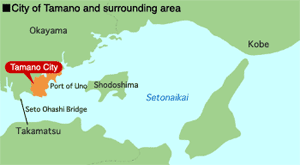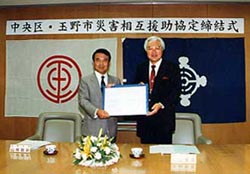Ocean Newsletter
No.26 September 5, 2001
-
Disaster Prevention from the Ocean Perspective
Suminao MURAKAMI Honorary Director, Laboratory of Urban Safety Planning / Selected Papers No.2(p.23)
When it comes to earthquakes, facilities positioned on the ocean surface are in a far superior location from the disaster prevention point of view. However, in order to make the most of these superior facilities at the time of an earthquake, consideration of systems that provide unspoiled links with facilities on land are very much required. For this purpose, we must review what happened when previous earthquakes struck, and carry out scenario investigations based on the information obtained.
Selected Papers No.2(p.23) -
A Disaster Prevention Support System Using Rivers and the Ocean
Kunihiko HIRAI Professor, Nagaoka Institute of Design / Selected Papers No.2(p.25)
The maintenance of an extensive transport network system that organically ties up land, sea and air is a major point in the discussions involving earthquake counter measures. An infinite amount of small and large rivers flow through the plains on which large cities sit. These river routes need to be characterized as an extension to ocean routes and used more effectively to promote the improvement of the transportation network.
Selected Papers No.2(p.25) -
Mutual Earthquake Support Agreements Linked By the Oceans
Yoshinori YAMANE Mayor of Tamano City, Okayama Prefecture / Selected Papers No.2(p.27)
Taking heed of the lessons taught by the "Great Kobe Earthquake", Tamano City of Okayama Prefecture, which faces the Seto Inland Sea, has begun to promote improved earthquake resistance of its harbor facilities, in order that the functions of its harbor aren't paralyzed by the occurrence of a major earthquake. Furthermore, a mutual support agreement has been formed by Tamano City with the harbor municipality of Chuo-ku, Tokyo. Through this agreement, a mutual cooperative arrangement, which includes the rescue of disaster victims, the provision of relief supplies and much other support, has been successfully set in place.
Selected Papers No.2(p.27) -
Searching for 'Hope' in Disaster Prevention Measures from the Ocean
Mineo SUGIYAMA Chief of Disaster Countermeasures Office, Disaster Prevention Bureau, Shizuoka Prefecture
When land transport is blocked by the influence of a natural disaster, the provision of rescue support services by sea to the devastated area become critically important. In Shizuoka, the primary ports in the prefecture have been made designated centers of disaster prevention and the disaster prevention TSL vessel "Hope" (Literally translated; its actual Japanese name is "Kibo") has been put into service to respond quickly to the rescue requirements of any areas devastated by natural disaster.
Mutual Earthquake Support Agreements Linked By the Oceans
Taking heed of the lessons taught by the "Great Kobe Earthquake", Tamano City of Okayama Prefecture, which faces the Seto Inland Sea, has begun to promote improved earthquake resistance of its harbor facilities, in order that the functions of its harbor aren't paralyzed by the occurrence of a major earthquake. Furthermore, a mutual support agreement has been formed by Tamano City with the harbor municipality of Chuo-ku, Tokyo. Through this agreement, a mutual cooperative arrangement, which includes the rescue of disaster victims, the provision of relief supplies and much other support, has been successfully set in place.
Applying the lessons of the Hanshin-Awaji Earthquake in harbor construction

The City of Tamano is located on the shores of Japan´s Inland Sea, or Setonaikai, in the eastern part of the sea known as Higashibisanseto. Since the 19th century the city´s port, Uno, has been linked to the port of Takamatsu,across the Inland Sea in Shikoku, by a ferry service. For much of its recent history, the city´s growth has been powered by its proximity to the ferry landing and by a local shipbuilding industry. In 1988 the Seto Ohashi Bridge was completed, linking Honshu, the mainisland of Japan and Shikoku. At the same time the old ferry service was replaced by a frequent local service, departing every 20 minutes day and night and calling at nearby islands such as Shodoshima and Naoshima in addition to Uno and Takamatsu.
Before the bridge was constructed, the port of Uno was host to a constant stream of travelers passing over the straits. However, several levels of government are taking steps to boost seaborne traffic on the Inland Sea. In other regions, dedicated cargo berths are being built. To revive the movement of people by sea,the Ministry of Transportation (now MLIT) tabled a plan called Port Renaissance 21.Based on this plan, the area of the Uno ferry wharf was designated a "people port," meaning a port for the transportation of tourists, and efforts were stepped up to build a wharf for ocean-going cruise vessels and to modernize the ferry terminal.The development of the City of Tamano is now focused clearly on maritime traffic, as Tamano builds a new port culture that is open to the world.
In setting a plan for the development of people ports in 2003, Tamano took great pains to design ports to provide solid backup in the event of major disasters. This decision was prompted when, in the wake of the Hanshin-Awaji Earthquake, Tamano sent relief supplies, firefighters and work vehicles to the scene of the disaster, but their arrival was delayed due to chaos on the roads. The city switched to marine transportation from the port of Uno to Kobe, but Kobe´s port was devastated by the quake and scarcely able to function. This terrible experience underscored the crucial importance of earthquake-resistant port facilities.
Mutual Earthquake Support Agreement between port cities
 Signing ceremony for the Mutual Earthquake Support Agreement between Chuo-ku and Tamano City. Pictured are Mr. Yoshihide Yada, Mayor of Chuo-ku (right) and the author (left).
Signing ceremony for the Mutual Earthquake Support Agreement between Chuo-ku and Tamano City. Pictured are Mr. Yoshihide Yada, Mayor of Chuo-ku (right) and the author (left).
Recent moves in Japan to devolve powers to local governments are helping Japan´s cities to develop greater autonomy and individuality. To develop stronger ties of commerce and promote the exchange of ideas, many cities are partnering with each other through sister-city agree-ments and inter-city exchanges. In Tamano, we quickly realized that Chuo-ku of Tokyo would be a good fit for such an agreement, for several reasons. First, many companies with places of business in Tamano have their head offices in Chuo-ku. Second, in the event of an earthquake or similar disaster, the chances of both locations being struck at the same time are slim, as the two cities are more than 700km apart. Finally, in the event that a disaster renders the roads impassable, the port of Harumi in Tokyo and the port of Uno in Tamano could be used to deliver relief supplies and dispatch relief workers by sea, provided that both ports made diligent preparations to implement earthquake-resistant infrastructure. Following discussions with Chuo-ku, in 1996 the City of Tamano and Chuo-ku concluded a Mutual Earthquake Support Agreement.
The agreement offers a number of specific assurances.Our two cities agree to assist each other in the evacuation of disaster victims, to provide facilities for temporary supply, and to provide equipment and materials for rapid recovery from disasters, including vehicles for emergency relief efforts, food, drinking water and medical supplies. Medical and technical personnel will also be dispatched as required. We believe that the strong bonds of cooperation this agreement builds will foster a spirit of full and mutually rewarding exchange between the two cities, not only at the government level but among individual citizens and residents as well.
As Mayor of Tamano, it is my basic responsibility to ensure the safety and security of residents. As the devolution of authority to local governments continues in Japan, I am confident that Chuo-ku, the heart of the nation´s capital and the largest metropolis, and Tamano, a small city nestled in a beautiful natural environment, can complement each other to improve the quality of life for the people of both our constituencies.
